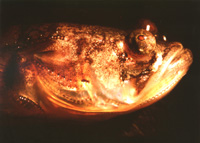Fossilized fish with big ears and nostrils unearthed in Australia
According to a new study, a fish that swam on an ancient barrier reef in Australia 380 million years ago had fins and nostrils remarkably similar to the limbs and ears of the first four-limbed creatures to walk on land.

Four-limbed land animals, also known as tetrapods, such as modern amphibians, reptiles, birds, and mammals, evolved from lobed-finned fish.
That transition from water to land has long fascinated scientists, but the fossil record of how it occurred is still incomplete.
The new finding suggests that certain aspects of tetrapod ears and limbs can be traced much further back in "fishy looking" fish than had been previously known, says John Long, head of sciences at Museum Victoria in Melbourne, Australia, reports National Geographic.
"The specimen is the most perfect complete three-dimensional fish of its kind ever discovered in the whole world," says Dr Long, who reports the team's findings online today in the journal Nature .
"It looks like it died yesterday. You can still open and close the mouth."
Dr Long says the preserved remains of a Gogonasus fish from the Devonian period were found last year in the remote Kimberley area at the Gogo fossil site, once an 'ancient barrier reef' teeming with fish.
He says previous analyses based on limited material suggested Gogonasus had relatively primitive features, informs ABC Online.
With a computed tomography (CT) machine, which beams X-rays at hundreds of different angles around an object one slice at a time, the scientists created three-dimensional images of the skeleton.
The fish had a big hole in its head. Called a spiracle opening, the cavity leads down into the gill chamber used for breathing and is thought to be the forerunner for the middle ear in modern land animals.
The fossil also showed the beginnings of a wrist joint and a complete front fin, consisting of the same arm bones found in humans and four-legged animals — the humerus, radius and ulna.
The scientists suspect the fish used the front limb to push off the sea bottom and lunge at prey.
"So it could've rested on those fins and then just pushed off. I think rather than walking on land, it was using this to push itself out of the reef to catch prey," Long said. "The fins needed to be strong and muscular, because the thrust was coming from the front of the animal and not from the tail," informs FOX News.
Subscribe to Pravda.Ru Telegram channel, Facebook, RSS!


